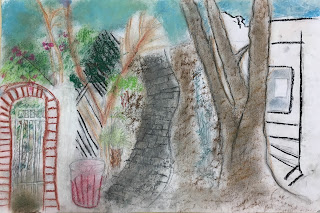 |
| Student landscape example |
How gorgeous are those colors?! This project is a labor of love and really challenges students to observe and explore materials.
The first major project in the 4th grade curriculum is a landscape drawing unit. We start out by discussing genres of painting: portrait, still life, and landscape. Then we identify the parts of a landscape: foreground, middle ground, and background. Students view examples of landscapes from different cultures, particularly Western artist Vincent van Gogh and Chinese ink drawings. Students without training tend to render scenes and objects as flat and formless. By examining famous examples from art history, students begin to notice the techniques artists use to render spaces with dimension. Students quickly recognize three techniques to show perspective in a painting.
 |
| Vincent Van Gogh, Fishing Boats on the Beach at Saintes-Maries, June 1888, Van Gogh Museum, Amsterdam, Netherlands. (Wikipedia) |
Technique #1: Overlapping. Take a look at van Gogh's boats and how only the first boat nearest to the viewer is entirely visible. The artist created perspective and space by hiding parts of the boats behind the first one to make the scene more realistic. Viewers feel like they would have to walk on the beach to see the rest of the boats.
 |
| Vincent Van Gogh, Olive Trees with Yellow Sky and Sun, 1889, Metropolitan Museum of Art, New York, USA. (Wikipedia) |
Technique #2: Relative size. Place your hand in front of your face and notice its size. Pull your hand back and notice that it now appears smaller. Did your hand actually shrink? Of course not! Your eye sees your hand as smaller to tell your brain that your hand must be further away. Artists place objects that are relatively larger in the foreground, closer to the viewer. Objects that are further away are painted to be smaller. Van Gogh wasn't seeing new, smaller trees in the background, instead he painted them as they appeared to his eye - smaller because they were further away from where he was painting.
 |
| Dai Jin, Landscape in the Style of Yan Wengui, Early Ming Dynasty 1368-1644. |
Technique #3: Atmospheric perspective. Difficult to pronounce but easy to see. Students will probably notice that objects in the foreground are much more detailed than the objects in the background. Artists may blur objects or use weather elements to suggest depth in their paintings.
 |
| Student landscape example |
To start this project, students will select a landscape that has meaning to them - a favorite place, somewhere they visited, a home country, etc. Students should bring in a photograph of their chosen place and make sure it features the natural world with a foreground, middle ground, and background. It may be helpful for them and for you as a formative assessment to have students label or somehow identify these areas on their photograph. It is also helpful for students to find the horizon line or place where the flat/foreground elevation meets the vertical/background elevation. Finding this "line" centers students on their paper so they can judge relative size and make room for all of the details.
Some students will quickly grasp how to incorporate perspective techniques into their drawings. Some students... will not. I was a little alarmed when a particular student couldn't seem to follow the verbal suggestions and demonstrations I did for him individually. Then I remembered my old friend - the critique. I showed the video Austin's Butterfly and modeled constructive criticism for students so they could provide peer feedback for a partner's rough draft sketch. Kids often speak to each other in a way that adults can't access while reinforcing their own understanding. Check out my post about using this video with students of any age - Critique: Using Student Feedback To Encourage Quality Work.
My students added color with chalk pastels and colored pencils. Make sure you demonstrate good practices with the chalk pastels before distributing them to students: dipping in water; applying a few strokes of color and blending; tapping extra dust into the trash rather than blowing onto themselves/their neighbor/your classroom. Colored pencils provide more control for small details - which belong in the... foreground. A colleague used oil pastels finished by blending with baby oil in her classes that produced excellent results. There are so many options here!
 |
| Last student example. This was done by a student just looking out the window of the classroom. Love! |
Vocabulary
Genre
Landscape
Still Life
Portrait
Foreground
Middle Ground
Background
Perspective
Space
Vincent van Gogh
Overlapping
Relative Size
Atmospheric Perspective
Horizon Line
Do you have any tried and true chalk pastel techniques? With which grades do you explore landscape drawing and painting?
Artfully,
Catherine
No comments:
Post a Comment